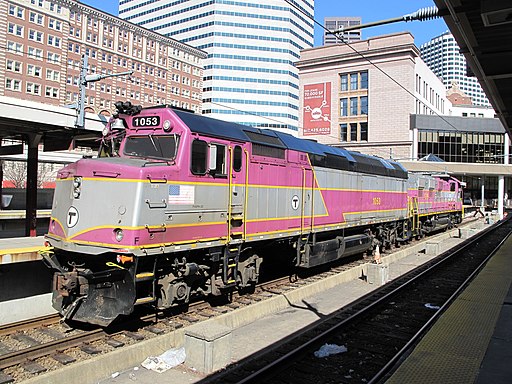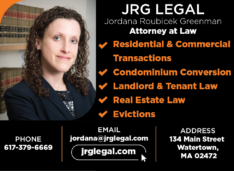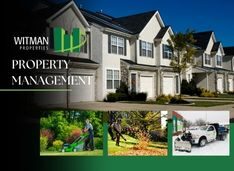How Does Transportation Affect Housing?
| . Posted in News - 0 Comments
By Kimberly Rau, MassLandlords, Inc.
It’s no secret that some areas of Massachusetts, particularly Boston, are pricey places to rent or buy property. In fact, a recent study places Boston third on the list of the most expensive rental markets in the country (ranking behind San Francisco and New York City in first and second place, respectively). But while high rents can certainly affect a city’s affordability rating, transportation costs also play a role in determining who can afford to live someplace. Transportation, and the zoning reform that often goes along with it, can create new housing opportunities, allowing landlords to obtain more rental units and grow their businesses. In other words, it’s a win-win for renters and landlords alike.

Homes located near convenient public transportation have higher property values, which is good news for landlords.
Das48 / CC BY-SA
Smaller cities face bigger transportation issues
Research from the Department of Housing and Urban Development (HUD) shows that cities with populations under 250,000 often struggle with making strong connections between housing, public amenities and transportation options.
Land closest to public transportation and other amenities is often more expensive than land in outlying areas, so builders of affordable housing “often select sites located on the city’s periphery, where residents are forced to rely on car transportation — a challenge for the 18 percent of households earning less than $35,000 that do not own a car,” HUD reports.
Furthermore, living in one of those housing units could greatly increase a family’s transportation expenses, as they may need to purchase a car or rely on transportation services to access public transportation. A study from Harvard’s Joint Center on Housing Studies reported that lower income renters spent 4.4 percent of their monthly income on commuting, compared to just 1.1 percent spent by renters earning higher incomes.
The role of transit on property values
Even cities with extensive public transportation options can have housing issues if the public transportation is unreliable. It can also have a serious effect on housing prices and home values.
A 2017 Redfin study showed that Boston had a transit score of 74, but also noted that one transit score point could affect a home’s median price by $3,585, or 1.1 percent. In other words, being closer to the T could allow you to seek a higher asking price to sell your home, or charge more in rent... but only if the MBTA is functioning the way it should be and the highways are at least somewhat navigable.
According to a 2019 article by RealEstate (by boston.com), titled “Will transportation woes drive down home prices?,” people pay high amounts of money to own or rent as close to Boston as possible, “partly because of the quality and quantity of jobs here.” But, it went on to say, if highway conditions remain as congested as they are, and the MBTA remains unreliable (e.g., among other issues, the article reports 43 derailments between 2014 and 2018, the second-highest in the nation after New Orleans, per the Boston Globe), major employers could start moving out of or avoiding the city.
“If it’s too hard for… workers to get to their jobs, other rival areas will become more attractive to employers,” says Eric Bourassa, Metropolitan Area Planning Council director of transportation, in the article. However, as long as there are still employment opportunities in Boston, there’s no reason to think bad transportation alone will tank housing numbers.
That said, the opposite correlation can also be made: New transit options can increase property values. For instance, in 2016, the MBTA added to its line express trains that could travel from Worcester to Boston in less than an hour. The number of people utilizing the commuter rail had already been increasing, according to data from 2012-2018. But the Framingham/Worcester line alone saw an increase of 45.7 percent in ridership, and in that same time period, home values began to rise as well.
No one is claiming that this was strictly due to expanded transportation options, but statistics show that existing transit can help pave the way for new development, in part because people are less concerned about the impact of traffic in their community if developers can point to nearby public transit, Bourassa said.
Of course, proximity to transit only positively affects property values (and, by extension, rent numbers) if it’s the “right” kind of transportation. People will pay a premium to live near an MBTA station in Boston, but it’s going to be a hard sell to ask the same kind of rent for a place in close proximity to a highway on-ramp. Convenience is good, but nuisances like a noisy freeway are less than desirable.
Public transit can positively affect parking issues
It’s no secret that there’s a shortage of affordable housing units in urban Massachusetts areas such as Boston. The law of supply and demand tells us that fewer units means higher rents, which only exacerbates the problem of finding affordable housing for many Massachusetts residents. Many factors influence how many new units may be built in any given area, but data collected by the Metropolitan Area Planning Council (MAPC) in 2019 suggests that public transit could provide a solution.
The data MAPC collected at almost 200 multifamily developments in 14 cities and towns showed that “most of the communities in Metro Boston have built more residential off-street parking than is needed or utilized.” Up to 30% of available parking spaces were sitting empty, even at peak parking times, such as overnight on the weekend.
“Local zoning rules often mandate excessive parking even as many homeowners and renters do not own vehicles and instead prefer public transit, biking, car share, and ride-hailing services to get around,” MAPC wrote.
Combined, the empty spaces represented more than 41 acres of land and added $94.5 million in constructed costs, or approximately $5,000 per housing unit. MAPC suggested that this land could be better used for green space or additional housing units, which would both increase supply and lower costs for renters.
The push for transit-oriented development
MAPC’s study data also suggested that the demand for parking seemed to be influenced by supply. In other words, if parking was available, people were more inclined to use it, but easy access to transit could reduce demand as well.
Transit oriented development (TOD) strives to “create mixed-use, higher density communities that encourage people to live, work and shop near transit services and decrease their dependence on driving,” according to mass.gov. In other words, the goal is to incorporate these transit stations into the community in a way that makes people want to use them instead of relying on automobiles.
To be effective, TOD must exist within a quarter mile (a 5- to 7-minute walk) from transit stations. It must be pedestrian-friendly and have a reduced number of parking spaces, and must be designed in a way that encourages use.
Some TODs include transit stations in their development (such as Copley Plaza in Boston), while others focus on building reuse (Davis Square in Somerville). In less-urban areas, TOD works to cluster new development around transit stations, instead of leaving the area around them under-utilized.
Some residents run cold on TOD
TOD seems like a win-win for communities. Reducing auto use can be good for the environment and reduces traffic and the need for more parking. Efficient use of existing land can also be a boon for communities, including creating more housing options. But not everyone is in favor of such initiatives.
In Jamaica Plain, the landlord of a building that houses a brewery is suing to block homeless shelter Pine Street Inn from creating a long-term housing development that would get people off the streets. The development is slated to be a five-story building comprising studio and traditional apartments. The development is slated to have 202 units, but has allotted space for just 39 parking spaces. The Turtle Swamp Brewery is located across the street from the proposed Washington Street site, though the business’ co-owners, who rent the brewery space, have stated they are not officially affiliated with the lawsuit their landlord, Monty Gold, filed.
Transit needs density to succeed, but density without transit is difficult
It’s the problem of the chicken or the egg: Densely populated areas have a hard time thriving if transit options are not available, but creating transit in areas that are not already densely populated is also a tough sell. A 2019 report from the Massachusetts Housing Partnership (MHP) showed that most of the 261 transit station areas examined have fewer than 10 homes per acre surrounding them. This represents wasted opportunity to create more housing and mixed use zones that could stimulate the economy.
For example, a square acre has 208.7 feet on one side. If the average person can walk a mile (5,280 feet) in 20 minutes, they could cover a little more than a third of a mile (1,724 feet) in seven minutes, or just over 8.25 linear acres. Draw a circle with this radius, that means about 200 acres are walking distance to the center. Porter Square, in Somerville, has an average of 16.6 housing units per acre, or 3,300 homes walking distance to the redline. Compare that to Chelsea, which has an average of 3 housing units per acre (600 homes walking distance). It’s easy to see the possible growth potential, if towns embrace mixed use zoning.
TODEX, an app released by MHP, allows viewers to see those density statistics for themselves. MHP recognized that even in suburban areas with low density, the potential existed for rezoning and development that could allow both transit systems and the surrounding community to benefit.
Gov. Baker’s Housing Choice Initiative
The importance of transit in relation to housing is not lost on the State. In 2019, the governor filed legislation that would further the 2017 Housing Choice Initiative. This plan supports the creation of 135,000 new housing units by 2025, citing inadequate housing production as one of the state’s biggest challenges.
This newer legislation looks to “deliver necessary, targeted zoning reform” to encourage housing production in communities around the Commonwealth. Currently, zoning changes in municipalities must be approved by a two-thirds supermajority vote. Gov. Baker’s housing choice bill would allow cities and towns to pass zoning changes by a simple majority vote, in theory streamlining the process to allow for multifamily housing development.
If passed, the legislation would not mandate these changes, but will “allow municipalities that want to rezone for denser, transit or downtown oriented, and new housing development to do so more easily.”
The bill promotes many best practices that would qualify for simple majority approval, including adopting 40R “Smart Growth” zoning in town centers and areas near public transit. The types of zoning encouraged under 40R would include dense residential districts, or mixed-use zoning districts, including affordable housing. A simple majority vote could also reduce parking or dimensional requirements (think minimum parking lot sizes) and granting increased density via a special permit process.
The Joint Committee on Housing also added a special provision to the legislation that would allow local permit granting authorities to approve special permits for certain types of development by a simple majority vote, including circumstances where affordable housing is created near transit centers.
While some housing advocacy groups are in favor of the legislation (the Citizen’s Housing and Planning Association stated that while the bill was not a “standalone solution,” it looked forward to working with the state to get it passed), other organizations appear more critical. The journal Commonwealth expressed concern that the bill as it reads now does not offer enough protections for low-income families:
“The problem with Baker’s approach is that, in the short term, housing production in cities and towns with low property values close to transit drives up housing prices, causes gentrification, and leads to the displacement of low income residents. With a loosening of zoning restrictions across all cities and towns in the Commonwealth, cities like Brockton, Malden, and Lynn that are commuting distance from Boston, but where housing prices are currently low, would quickly become ripe for new high-end development. Low-income residents of these places will then either have to move out of the community or pay higher prices.”
Commonwealth suggested the bill should include a mandate for developers to build a higher percentage of affordable housing that is accessible to low-income renters, as well as include protections for groups most at risk of displacement.
Access to transit can only improve things for landlords
Zoning changes allowing for multi-family properties or more mixed-use zones won’t solve all of the state’s housing and transit issues by themselves. However, the data shows that in a state where space is at a premium, we can’t afford to continue squandering valuable square footage on parking spaces that will be left empty or allowing T stations to sit alone with nothing but a parking garage within walkable distance. Transit that is accessible on foot, and that affords easy access to housing and commercial opportunities, means more renters, better property values and more economic growth.




